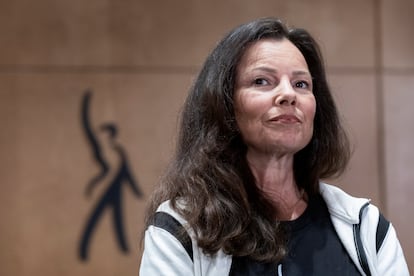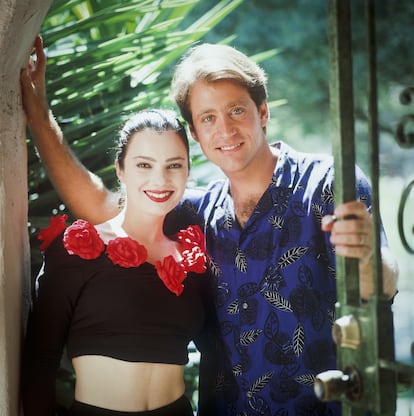Fran Drescher, the scatterbrained nanny-turned-labor-leader who’s now the face of the Hollywood strike
Known for ‘The Nanny’ TV series in the 90s, the actress overcame rape and cancer and reinvented herself as the president of the actors union


Criticism of Wall Street coupled with praise for the French Revolution may seem out of place in the heart of Hollywood. Even more unexpected is hearing such conversation within the elegant and austere confines of SAG-AFTRA, the U.S. actors’ union, a cornerstone of the film industry which sustains 2.4 million workers and generates an astounding $190 billion (€170 billion) in annual wages. Surprisingly, it was the beloved 90s star Fran Drescher who sparked these passionate anti-capitalist statements. As the current SAG-AFTRA union president leading negotiations with studios, she remains firm in demanding increased compensation for her colleagues. On July 13, she boldly declared a strike of over 160,000 performers, effectively paralyzing the industry with no resolution in sight.
Fran Drescher is not your typical star — she hasn’t been one for 40 years. She was born in Queens (New York) to parents of Polish and Romanian ancestry, but didn’t always know she wanted to act. In the 1970s, when she learned that the acting classes she wanted were full, Drescher enrolled in a cosmetics course instead. What seemed like a setback was actually a leap forward.
Drescher’s association with The Nanny, the TV series she created, produced, wrote and starred in, made her a household name. Her on-screen alter ego, Fran Fine, shares her first name. The half-hour show ran for 146 episodes over six seasons (1993-1999) and earned her an estimated $30 million. Each episode averaged 10 million viewers in the U.S., and by the final season, Drescher was paid $1.5 million per episode. The show’s international success spanned 80+ countries, with local adaptations in Turkey, Italy, Indonesia, Argentina and Russia.

Fran Fine wasn’t always a nanny — she was a beautician who unexpectedly became the babysitter for a wealthy widower’s three children. The show was immensely popular in its first season, thanks to the protagonist’s charisma, humor, acting skills and stunning wardrobe designed by renowned fashion designers like Versace and Thierry Mugler that were later displayed in prestigious exhibits.
When she was just 20 years old, Drescher made her debut in the Saturday Night Fever (1977), boldly asking Tony Manero (John Travolta), “Are you as good in bed as you are on the dance floor?” But her success wasn’t just about a lucky break — her undeniable talent soon became the talk of the town.
Before the nanny came into her life, Drescher had already breezed through TV episodes of Night Court, ALF and Fame. She had worked with notable directors like Wes Craven (in Stranger in our House), Rob Reiner (in This Is Spinal Tap), and Francis Ford Coppola (in Jack). Drescher married her high school sweetheart, Peter Marc Jacobson, who played a pivotal role in shaping the outspoken and theatrical character of The Nanny, and even directed her in 20 episodes. The series garnered praise from audiences and critics alike, earning Drescher two Emmy nominations and two Golden Globe nominations.

By the time The Nanny ended its run, Drescher and Jacobson were divorced. They separated in 1996, during the peak of the show’s popularity, and officially divorced three years later. During the separation, Jacobsen came out as gay. At a 2015 awards ceremony in New York, Drescher jokingly shared, “I have a gay art dealer, a gay dermatologist, not to mention my hairdresser… and a gay ex-husband!” Drescher says, “People often ask me, ‘How did you not know?’ Well, the truth is, he loved interior design, fashion and clothes, but we still had a great sex life.” This experience naturally inspired another TV series — Happily Divorced — that Drescher and Jacobsen created together as an amicably divorced couple.
Drescher and Jacobson lived together for years in Malibu, the wealthy seaside enclave north of Los Angeles. But years before, they suffered a life-changing incident in 1985 when a paroled convict and his brother broke into their home to rob them, and raped Drescher and a friend at gunpoint. Jacobson was tied up and forced to watch. After that, they moved in with good friends Dan Aykroyd and Donna Dixon, and told no one until Drescher’s biography was published in 1996. The trauma lasted for years. In a CNN interview, Drescher said she helped a police sketch artist create a likeness of her rapist, which led to his capture and sentencing to 150 years in prison.
Drescher faced another challenge when, at the age of 42, she was diagnosed with uterine cancer. This came after a misdiagnosis that resulted in her receiving the incorrect treatment, which worsened her condition. In June 2000, she underwent an urgent hysterectomy. Seven years later, she published a successful book about her personal and medical journey, and established the Cancer Schmancer foundation. The foundation focuses on raising awareness about cancer prevention and early detection. Drescher gives inspirational speeches and raises funds to support patients. On the foundation’s website, Drescher writes, “My whole life has been about turning negative experiences into positive ones… I got famous, then I got cancer, and now I live to talk about it. Sometimes the best gifts come in the ugliest packages. Please lock elbows with me and join the Cancer Schmancer Movement so together we can do what needs to be done, so fewer of us will die prematurely.”
The journey hasn’t been easy, but Drescher always maintains a great sense of humor and never holds back in negotiations, press conferences and picket lines outside studios. More than just a famous face, she also exhibits a deep understanding of the industry. Entertainment news sources say she is the one who proposed and pushed for streaming platforms to pay better residuals to actors. After a hard-fought race, Drescher was elected president of SAG-AFTRA in June 2021. At the time, her ability to manage a powerful union and her industry knowledge were questioned by many. Concerns were also raised about her views on health, vaccines and medicine, and her ability to unite a divided union. But time has proven her critics wrong. Her popularity is on the rise, and she rallied the union to vote 98% in favor of the strike.
Drescher’s fiery words about capitalism, the studios and their business model have intensified recently. “You’re on the wrong side of history;” “You have disrespected us;” “Shame on you;” are some of the many missiles Drescher has launched at the studios.
But this isn’t the first time Drescher has shown her radical side. In a 2017 interview with Vulture magazine, Drescher openly said she was against capitalism. While she’s not opposed to making money, she believes it should be balanced with things that are truly valuable. Describing capitalism as frenzied and cannibalistic, she acknowledges that being a queer icon has given her a platform to speak out about the money-obsessed sociopathic elites who have lost sight of what is truly beautiful in this world.

She leans left in her political ideology, or what is considered left-wing in the U.S. A proud Democrat, she has supported Joe Biden, Barack Obama, and Bill and Hillary Clinton. Interestingly, when Hillary became U.S. Secretary of State, Drescher briefly considered running for the U.S. Senate seat vacated by Clinton. Some might find Drescher’s glitzy image a sharp contrast with her political beliefs, but she has a swift response for those critics as well. When she attended the Dolce & Gabbana Haute Couture fashion show in Italy (an ocean away from the imminent strike in Hollywood) with Kim Kardashian (who called her a fashion icon to her massive 360 million followers), Drescher dismissed critics by saying it was a work-related trip. Duncan Crabtree-Ireland, SAG-AFTRA’s chief negotiator, rallied behind Drescher saying, “Fran was working, which is what our members do… She has been in negotiations every day, either in person or via videoconference. President Drescher is managing a physically demanding schedule across three time zones, overseeing negotiations and working on-location.”
Drescher also defended the photo she took with Kim Kardashian in Italy around the same time negotiations between actors and production companies began to break down. “I was in hair and makeup three hours a day, walking in heels on cobblestones, doing things like that, which is work — not fun. I’m sure Kim would have rather been at her home in Malibu with her children, too, but we work. That’s what we do,” she said defiantly, her tired face devoid of makeup. Seasoned nanny Fran Drescher is showing the world that she can stand the heat and won’t get out of the kitchen.
Sign up for our weekly newsletter to get more English-language news coverage from EL PAÍS USA Edition
Tu suscripción se está usando en otro dispositivo
¿Quieres añadir otro usuario a tu suscripción?
Si continúas leyendo en este dispositivo, no se podrá leer en el otro.
FlechaTu suscripción se está usando en otro dispositivo y solo puedes acceder a EL PAÍS desde un dispositivo a la vez.
Si quieres compartir tu cuenta, cambia tu suscripción a la modalidad Premium, así podrás añadir otro usuario. Cada uno accederá con su propia cuenta de email, lo que os permitirá personalizar vuestra experiencia en EL PAÍS.
¿Tienes una suscripción de empresa? Accede aquí para contratar más cuentas.
En el caso de no saber quién está usando tu cuenta, te recomendamos cambiar tu contraseña aquí.
Si decides continuar compartiendo tu cuenta, este mensaje se mostrará en tu dispositivo y en el de la otra persona que está usando tu cuenta de forma indefinida, afectando a tu experiencia de lectura. Puedes consultar aquí los términos y condiciones de la suscripción digital.
More information
Archived In
Últimas noticias
Welcome to the post-religion era: The idea of Christianity as the absolute truth has become obsolete
‘I thought you would like it’: The risky sexual practice popularized by TV shows and TikTok
The digitalization of tourism: ‘They promise experiences and gave us the worst possible one’
Mexican peso defies uncertainty with forecasts of a new period of stability in 2026
Most viewed
- Sinaloa Cartel war is taking its toll on Los Chapitos
- Oona Chaplin: ‘I told James Cameron that I was living in a treehouse and starting a permaculture project with a friend’
- Reinhard Genzel, Nobel laureate in physics: ‘One-minute videos will never give you the truth’
- Why the price of coffee has skyrocketed: from Brazilian plantations to specialty coffee houses
- Silver prices are going crazy: This is what’s fueling the rally










































